University researchers analyzed object and facial recognition in six- and ten-month-old infants for a study published in Developmental Science. Kristen Tummeltshammer, postdoctoral fellow, and Dima Amso, associate professor of cognitive, linguistic and psychological sciences, collaborated on an experiment in which babies were tasked with using contextual cues in order to locate faces on a screen.
An arrangement of four dots were displayed and, after a short time, were flipped to reveal either an animated face or mere objects. Though the arrangement would alternate randomly, half of the time the same arrangement would reappear, leading the babies to react and locate the face faster due to quick learning and association of the face’s location.
The results point toward remarkable cognitive development in this skill early on in infancy. Babies “are efficient in using the structure in their environment to maximize attentional resources on the one hand and to reduce uncertainty and distraction on the other,” said Amso in a University press release.
“We’re always interested (in our lab) in understanding how infants and young children typically develop,” said Tummeltshammer. “If we can understand how these abilities are developing early on in a typical population then we can apply it to neurodevelopmental disorders,” she added. The research also helps illuminate the building blocks of cognition. “We would hope we are tapping into mechanisms that are fundamental to human cognition. … These are attentional and learning strategies that we take through our whole life,” Tummeltshammer said.
The study has received praise from outside experts in the field of cognitive development. Janet Frick, associate professor of behavioral and brain sciences at the University of Georgia and Julie Markant, assistant professor at Tulane University, both commented on the study’s goals and design. “It’s a very creative study and a great use of eye-tracking to ask some higher-level questions about the early development of cognition,” said Frick.
“I thought the design was really creative. … It’s really the first paper to look at this concept of contextual cuing in infancy,” said Markant.
Both researchers had high hopes for the implications of the research. “Any time that we have a better understanding of how early cognitive development typically emerges, then that’s going to be useful for identifying deviations to that, and trying to identify ways of intervening,” Frick said. “As developmental scientists, we are always thinking about the fact that understanding typical development is going inform our understanding of atypical development,” Markant said. “This is a stepping stone, because we need to know what is supposed to happen in order to understand what goes awry.”
Plans for future experiments are also on the horizon. “With this study, it’s going to be scaling up the complexity of the scenes we’re presenting to infants and seeing whether they can take this skill of using contextual cues into a more naturalistic environment,” Tummeltshammer said. The researchers are intrigued by the real-life applications of these cues, Tummeltshammer said. “Hopefully we are tapping into something that is fundamental about human learning,” she added.





